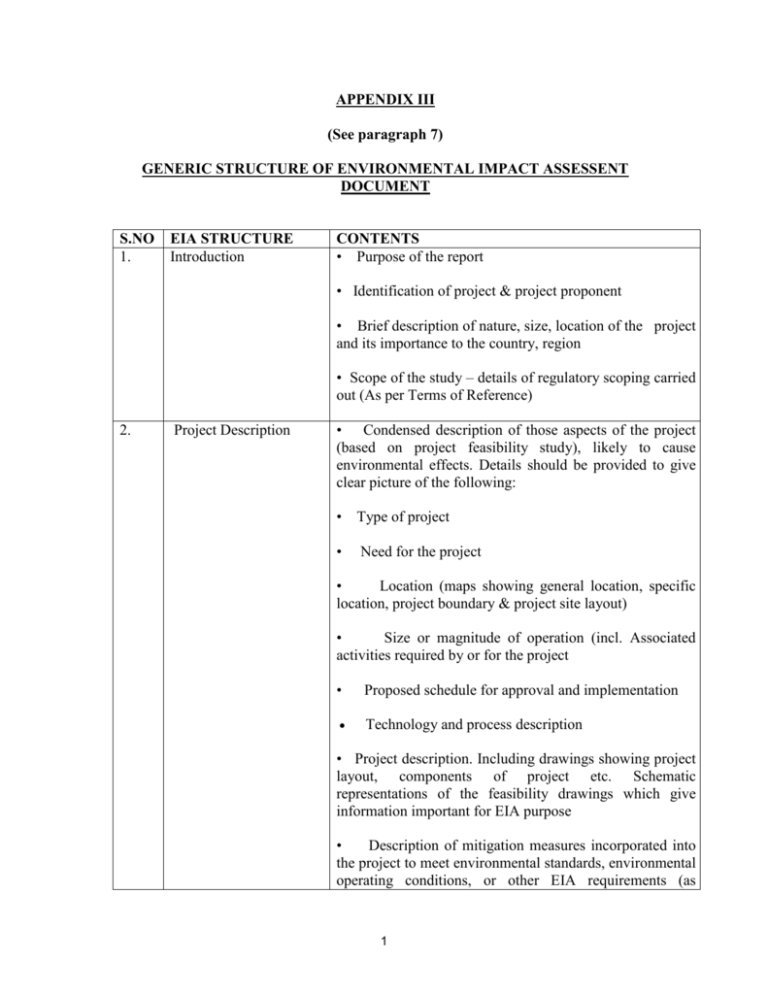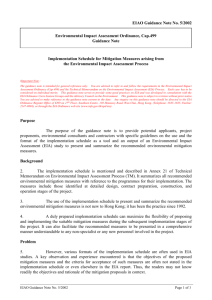Generic Structure of Environmental Impact Assessment Document
advertisement

APPENDIX III (See paragraph 7) GENERIC STRUCTURE OF ENVIRONMENTAL IMPACT ASSESSENT DOCUMENT S.NO 1. EIA STRUCTURE Introduction CONTENTS • Purpose of the report • Identification of project & project proponent • Brief description of nature, size, location of the project and its importance to the country, region • Scope of the study – details of regulatory scoping carried out (As per Terms of Reference) 2. Project Description • Condensed description of those aspects of the project (based on project feasibility study), likely to cause environmental effects. Details should be provided to give clear picture of the following: • Type of project • Need for the project • Location (maps showing general location, specific location, project boundary & project site layout) • Size or magnitude of operation (incl. Associated activities required by or for the project • Proposed schedule for approval and implementation Technology and process description • Project description. Including drawings showing project layout, components of project etc. Schematic representations of the feasibility drawings which give information important for EIA purpose • Description of mitigation measures incorporated into the project to meet environmental standards, environmental operating conditions, or other EIA requirements (as 1 required by the scope) • Assessment of New & untested technology for the risk of technological failure 3. Description Environment of the • Study area, period, components & methodology • Establishment of baseline for valued environmental components, as identified in the scope • 4. Anticipated Environmental Impacts & Mitigation Measures Base maps of all environmental components • Details of Investigated Environmental impacts due to project location, possible accidents, project design, project construction, regular operations, final decommissioning or rehabilitation of a completed project • Measures for minimizing and / or offsetting adverse impacts identified • Irreversible and Irretrievable commitments of environmental components • Assessment of significance of impacts (Criteria for determining significance, Assigning significance) 5. • Mitigation measures Analysis of Alternatives • In case, the scoping exercise results in need for (Technology alternatives: & Site) • Description of each alternative • Summary of adverse impacts of each alternative • Mitigation measures proposed for each alternative and • Selection of alternative 6. Environmental Monitoring Program • Technical aspects of monitoring the effectiveness of mitigation measures (incl. Measurement methodologies, frequency, location, data analysis, reporting schedules, emergency procedures, detailed budget & procurement schedules) 7. Additional Studies • Public Consultation 2 8. Project Benefits 9. Environmental Benefit Analysis EMP 10. • Risk assessment • Social Impact Assessment. R&R Action Plans Improvements in the physical infrastructure Improvements in the social infrastructure Employment potential –skilled; semi-skilled and unskilled Other tangible benefits Cost If recommended at the Scoping stage • Description of the administrative aspects of ensuring that mitigative measures are implemented and their effectiveness monitored, after approval of the EIA • Overall justification for implementation of the project 11 Summary & Conclusion (This will constitute the summary of the EIA • Explanation of how, adverse effects have been Report ) mitigated 12. Disclosure Consultants engaged of The names of the Consultants engaged with their brief resume and nature of Consultancy rendered 3











